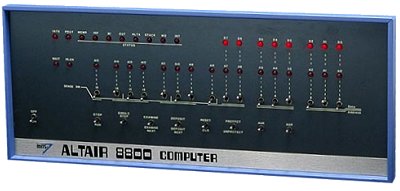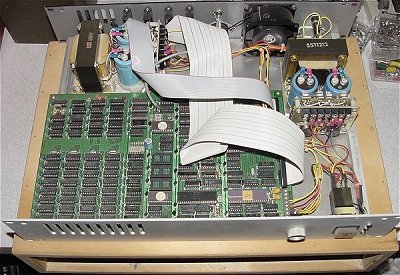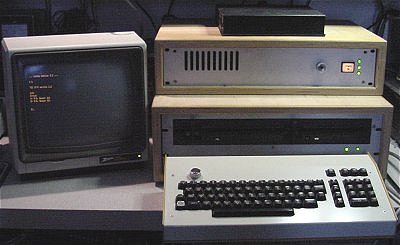Although electronic computers had been used by the military and businesses for many years, the first computers intended for hobbyists and home use did not appear commercially until the mid 1970s when integrated circuits reduced the size and cost of the central processing units (CPU). Most of these early computers were in kit form.
The Altair 8800
One of the earliest computers marketed for hobbyists was the Altair 8800. The Altair was designed around the 8080 CPU. Although there were earlier boards with instructions offered, the Altair 8800 was most likely the first complete computer kit containing all the components needed build the main processing unit. The kit also included the case and front panel.

Front panel of the Altair 8800.
The Altair was a gamble at the time and at least 200 kits would need to be sold at $400 each to break even. Within a few short months of being released in 1975, reportedly over ten times the original 200 units were sold. Eventually an assembled version was also offered for around $200 more than the price of the initial kit. Still due to the popularity of the Altair 8080 there was a considerable wait for the kit or an assembled version.
The Altair 8800 used a bus system where individual cards plugged into a larger bus board. This would allow expandability with the addition of additional plug in cards. This design most likely led to the popular S-100 Bus computers.
The Altair's 8080 processor only operated with an initial 256 bytes. In order to use the Altair for anything meaningful after it was built, you would also need to purchase additional memory boards and an I/O (input/output) board to communicate with a paper tape or cassette drive. There was no operating system, although an Altair with additional expanded memory could run an early version of Microsoft Basic.
Today an Altair 8800 in reasonably good cosmetic condition easily sells for upward of $2,000.00 at auction and sometimes more if any of the original peripherals are included with it.
The Apple Computer
The first Apple computer was released in 1976 after Steve Jobs quit Atari and convinced Steven Wozniak to leave Hewlett-Packard and form the Apple Computer Company. The first Apple computer was not really a kit as you purchased a completed board and attached a power supply and keyboard. You could then mount the board in a cabinet of your own design. Of the few photos I have seen of this early Apple, most were of units housed in homemade wood cabinets.
The early Apple's design allowed the user to input data using a keyboard and did not require setting switches and inputting data through other devices such as paper tape drives.
Only around 200 of these first Apple boards were sold. The second version called the Apple II launched in 1977 was not a kit and required no building as it came fully assembled in its own case. It also offered color graphics for the first time. The II became wildly popular and sales took off quickly launching Apple to the number one spot in the new home computer industry.
Finding one of the first Apple motherboards today would be similar to winning the lottery. Very few were manufactured and sold, and of these it's estimated that less than 10 still exist. Auction prices in recent years have ranged from $375,000 to $640,000.

The Ferguson Big Board computer was a single-board kit.
The Ferguson “Big Board”
In the early 1980s the Ferguson “Big Board” computer was offered by Digital Research Computers of Texas as a bare circuit board, a kit, or ready-to-go. Designed by Jim Ferguson, it was powered by a Z-80 processor with 64K of RAM and designed to run the CP/M (Control Program/Microprocessor) operating system. What made the Big Board unique was the fact that unlike previous kits, everything was on one circuit board including memory and I/O. Once the Big Board was built and hooked up to power supplies, you only needed to attach a composite video display monitor, ASCII keyboard, and 8-in. floppy-disk drives to have a fully functional computer that would run the CP/M operating system along with early word-processing and spreadsheet programs.
The Big Board became so popular that many user groups sprang up across the country and in 1981 an entire magazine called Micro Cornucopia began publishing with its articles focused on the Big-Board computer source code and the CP/M operating system. Micro Cornucopia magazine continued publishing through the 1980s.
It's interesting to note that Digital Research Computers of Texas who manufactured the Big Board kits was a completely separate company from Digital Research of California, the company that developed the CP/M operating system the Big Board used.
Besides the popularity of being a single-board computer, the documentation that was included with the Big Board was extensive, which, I'm sure, led to its popularity with hobbyists. I, along with several engineers where I worked at the time, purchased a batch of unpopulated circuit boards. My Big Board included several notebooks which contained not only the schematics, parts lists, and assembly instructions, but also the theory of operation of the entire system and a PFM-80 User's Manual. I have seldom seen as thorough documentation for any kit or piece of electronic equipment as I received with my original Big Board circuit board.
The Ferguson Big Board's single board design and popularity was instrumental in Xerox's micro computer products which used a version of the Big Board in it's 8080 computers. A few years later the popular Kaypro brand home computers were also based on Jim Ferguson's original Big Board design.

A completed Ferguson Big Board computer.
I still have my original Ferguson Big Board and documentation. I originally paid $125 for the bare board with documentation. By the time I had added the board components, hard drives, keyboard, and monitor I had spent just under $900, which at the time was less than other options like the soon-to-be-released IBM PC at over $1,500.
Every once in a while I set it up, plug in the 8-in. hard drives, keyboard, and monitor, put in the CP/M operating disk, boot it up, and run an early version of the WordStar word-processing program. It's been over 30 years and everything still works as well as the day I finished building it.
Today pricing varies on the original Big Boards and kits. Although thousands were manufactured, they can be hard to find. I've seen completed kits with all original documentation sell for hundreds of dollars at auction and a few of the original unpopulated boards by themselves without documentation sell for under $200. Still, there are many hobbyists today experimenting with these kits.
For more information and examples of early electronic technology view my collection at StevesAntiqueTechnology.com
Advertisement
Learn more about Electronic Products Magazine





